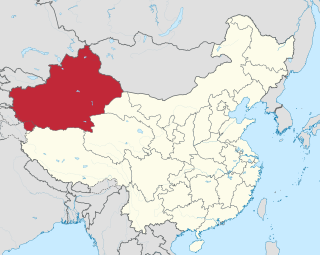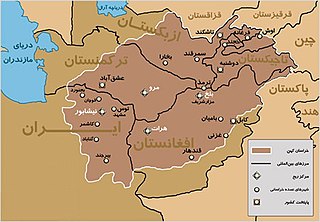Related Research Articles

The Muslim conquests of Afghanistan began during the Muslim conquest of Persia as the Arab Muslims migrated eastwards to Khorasan, Sistan and Transoxiana. Fifteen years after the Battle of Nahāvand in 642 AD, they controlled all Sasanian domains except in Afghanistan. Fuller Islamization was not achieved until the period between 10th and 12th centuries under Ghaznavid and Ghurid dynasty's rule who patronized Muslim religious institutions.

Central Asia is a subregion of Asia that stretches from the Caspian Sea in the southwest and Eastern Europe in the northwest to Western China and Mongolia in the east, and from Afghanistan and Iran in the south to Russia in the north. It includes the former Soviet republics of Kazakhstan, Kyrgyzstan, Tajikistan, Turkmenistan, and Uzbekistan. Central Asian nations are colloquially referred to as the "-stans" as the countries all have names ending with the Persian suffix "-stan", meaning "land of".

The ancient history of Afghanistan, also referred to as the pre-Islamic period of Afghanistan, dates back to the prehistoric era and the Indus Valley civilization around 3300–1300 BCE. Archaeological exploration began in Afghanistan in earnest after World War II and proceeded until the late 1970s during the Soviet–Afghan War. Archaeologists and historians suggest that humans were living in Afghanistan at least 50,000 years ago, and that farming communities of the region were among the earliest in the world. Urbanized culture has existed in the land from between 3000 and 2000 BC. Artifacts typical of the Paleolithic, Mesolithic, Neolithic, Bronze, and Iron ages have been found inside Afghanistan.
The Uzbeks are a Turkic ethnic group native to the wider Central Asian region, being among the largest Turkic ethnic group in the area. They comprise the majority population of Uzbekistan, next to Kazakh and Karakalpak minorities, and are also minority groups in Afghanistan, Tajikistan, Kyrgyzstan, Kazakhstan, Turkmenistan, Russia, and China. Uzbek diaspora communities also exist in Turkey, Saudi Arabia, United States, Ukraine, and other countries.

Tajiks are a Persian-speaking Iranian ethnic group native to Central Asia, living primarily in Afghanistan, Tajikistan, and Uzbekistan. Tajiks are the largest ethnicity in Tajikistan, and the second-largest in Afghanistan and Uzbekistan. They speak varieties of Persian, a Western Iranian language. In Tajikistan, since the 1939 Soviet census, its small Pamiri and Yaghnobi ethnic groups are included as Tajiks. In China, the term is used to refer to its Pamiri ethnic groups, the Tajiks of Xinjiang, who speak the Eastern Iranian Pamiri languages. In Afghanistan, the Pamiris are counted as a separate ethnic group.

The Hindu Kush is an 800-kilometre-long (500 mi) mountain range in Central and South Asia to the west of the Himalayas. It stretches from central and eastern Afghanistan into northwestern Pakistan and far southeastern Tajikistan. The range forms the western section of the Hindu Kush Himalayan Region (HKH); to the north, near its northeastern end, the Hindu Kush buttresses the Pamir Mountains near the point where the borders of China, Pakistan and Afghanistan meet, after which it runs southwest through Pakistan and into Afghanistan near their border.
Turkestan, also spelled Turkistan, is a historical region in Central Asia corresponding to the regions of Transoxiana and Xinjiang.

East Turkestan is a loosely defined geographical and historical region in the western provinces of the People's Republic of China, which varies in meaning by context and usage. The term was coined in the 19th century by Russian Turkologists, including Nikita Bichurin, who intended the name to replace the common Western term for the region, Chinese Turkestan, which referred to the Tarim Basin in southern Xinjiang or Xinjiang as a whole during the Qing dynasty. Beginning in the 17th century, Altishahr, which means "Six Cities" in Uyghur, became the Uyghur name for the Tarim Basin. Uyghurs also called the Tarim Basin "Yettishar," which means "Seven Cities," and even "Sekkizshahr", which means "Eight Cities" in Uyghur. Chinese dynasties from the Han dynasty to the Tang dynasty had called an overlapping area the "Western Regions".
The term Islamic republic has been used in different ways. Some Muslim religious leaders have used it as the name for a theoretical form of Islamic theocratic government enforcing sharia, or laws compatible with sharia. The term has also been used for a sovereign state taking a compromise position between a purely Islamic caliphate and a secular, nationalist republic — neither an Islamic monarchy nor secular republic. In other cases it is used merely as a symbol of cultural identity.

Greater Khorāsān, or Khorāsān is a historical eastern region in the Iranian Plateau between Western and Central Asia.
An Islamic state has a form of government based on sharia law. As a term, it has been used to describe various historical polities and theories of governance in the Islamic world. As a translation of the Arabic term dawlah islāmiyyah it refers to a modern notion associated with political Islam (Islamism). Notable examples of historical Islamic states include the state of Medina, established by the Islamic prophet Muhammad, and the Arab caliphate which continued under his successors and the Umayyads.

The early Muslim conquests or early Islamic conquests, also known as the Arab conquests, were initiated in the 7th century by Muhammad, the main Islamic prophet. He established a new unified polity in Arabia that expanded rapidly under the Rashidun Caliphate and the Umayyad Caliphate, culminating in Islamic rule being established on three continents. According to Scottish historian James Buchan: "In speed and extent, the first Arab conquests were matched only by those of Alexander the Great, and they were more lasting."
The composite Turko-Persian, Turco-Persian, Turco-Iranian, or Turko-Afghan tradition was a distinctive culture that arose in the 9th and 10th centuries in Khorasan and Transoxiana.
Pashtunization, also called Pathanization, is a process of cultural or linguistic change in which someone or something non-Pashtun becomes acculturated to Pashtun influence. Pashtuns are the largest ethnic group in Afghanistan and second-largest in Pakistan.

The ancestral population of modern Asian people has its origins in the two primary prehistoric settlement centres – greater Southwest Asia and from the Mongolian plateau towards Northern China.

The Indian subcontinent is a physiographical region in Southern Asia, mostly situated on the Indian Plate, projecting southwards into the Indian Ocean from the Himalayas. Geopolitically, it spans major landmasses from the countries of Bangladesh, Bhutan, India, Maldives, Nepal, Pakistan, and Sri Lanka. Although the terms "Indian subcontinent" and "South Asia" are often used interchangeably to denote the region, the geopolitical term of South Asia frequently includes Afghanistan, which is not considered part of the subcontinent. In historical sources, the term "India" was used to refer to the region southeast of the Indus River, persisting as a descriptor for the entire Indian subcontinent until the British Raj era, when it evolved to represent a distinct political entity and the later nation-state of India.

South Asia is the southern subregion of Asia, which is defined in both geographical and ethnic-cultural terms. As commonly conceptualized, the modern states of South Asia include Afghanistan, Bangladesh, Bhutan, India, Maldives, Nepal, Pakistan, Sri Lanka, and in some cases, Iran. South Asia borders East Asia to the northeast, Central Asia to the northwest, West Asia to the west and Southeast Asia to the east. Topographically, it is dominated by the Indian subcontinent and is bounded by the Indian Ocean in the south, and the Himalayas, Karakoram, and Pamir mountains in the north.

Lists of mosques cover mosques, places of worship for Muslims. The lists include the most famous, largest and oldest mosques, and mosques mentioned in the Quran, as well as lists of mosques in each region and country of the world. The major regions, Africa, Americas, Asia, Europe and Oceania are sorted alphabetically. The sub-regions, such as Northeast and Northwest Africa in Africa, and Arabia and South Asia in Asia, are sorted by the dates in which their first mosques were reportedly established, more or less, barring those that are mentioned by name in the Quran.

Transoxiana or Transoxania is the Latin name for a region and civilization located in lower Central Asia roughly corresponding to modern-day eastern Uzbekistan, western Tajikistan, parts of southern Kazakhstan, parts of Turkmenistan and southern Kyrgyzstan. Geographically, it is the region between the rivers Amu Darya to its south and the Syr Darya to its north.
The spread of Islam spans almost 1,400 years. The early Muslim conquests that occurred following the death of Muhammad in 632 CE led to the creation of the caliphates, occupying a vast geographical area; conversion to Islam was boosted by Arab Muslim forces conquering vast territories and building imperial structures over time. Most of the significant expansion occurred during the reign of the rāshidūn ("rightly-guided") caliphs from 632 to 661 CE, which were the first four successors of Muhammad. These early caliphates, coupled with Muslim economics and trading, the Islamic Golden Age, and the age of the Islamic gunpowder empires, resulted in Islam's spread outwards from Mecca towards the Indian, Atlantic, and Pacific Oceans and the creation of the Muslim world. The Islamic conquests, which culminated in the Arab empire being established across three continents, enriched the Muslim world, achieving the economic preconditions for the emergence of this institution owing to the emphasis attached to Islamic teachings. Trade played an important role in the spread of Islam in some parts of the world, such as Indonesia.
References
- ↑ Gladney, Dru C. (1993-01-01). "Hui Urban Entrepreneurialism in Beijing: State Policy, Ethnoreligious Identity and the Chinese City". In Guldin, Gregory; Southall, Aidan (eds.). Urban Anthropology in China. BRILL. p. 282. ISBN 9789004096202.
- ↑ Atwill, David G. (2005). The Chinese Sultanate: Islam, Ethnicity, and the Panthay Rebellion in Southwest China, 1856-1873. Stanford University Press. p. 34.
- ↑ Williams, Brian Glyn (September 22, 2011). Afghanistan Declassified: A Guide to America's Longest War. University of Pennsylvania Press. p. 103. ISBN 9780812206159.
- ↑ Ajami, Fouad (1992). The Arab Predicament: Arab Political Thought and Practice since 1967. Cambridge University Press.
- ↑ Jenkins, John Philip (2009). The Lost History of Christianity: The Thousand-Year Golden Age of the Church in the Middle East, Africa, and Asia-and How It Died. HarperOne. p. 163.
- ↑ Knudsen, Are J. (2002). Political Islam in South Asia. Chr. Michelsen Institute, Development Studies and Human Rights. p. 4. ISBN 9788280620262.